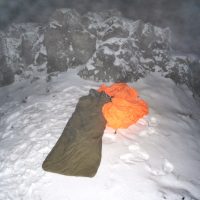 So this Saturday didn’t work out quite as I’d planned.
So this Saturday didn’t work out quite as I’d planned.
The day had started very promisingly. I woke from my overnight bivvy (pictured) above the snowline in Snowdonia ready for a glorious day’s winter walking in the mountains.
Cold, clear air, a fresh covering of snow. Half an hour’s walk to the summit of Glyder Fawr to watch the sunrise, then down and up over the Carneddau.
Except…
After just 15 minutes walking, the day took an unexpected turn when a short, innocuous slip, combined with my ice-axe wrist loop, resulted in a dislocated shoulder.
I was on my own. It was 7.30 in the morning and still below freezing. And there was no-one around.
So. What to do?
I tried to tease my shoulder back into place, but it wasn’t playing ball (“and socket?”).
I needed help, but I knew I also had to look after myself. I could cope with the pain for the time being, but the cold was a very real potential danger.
I was fortunately in mobile coverage, albeit emergency service calls only. So I got through to Mountain Rescue and gave them details and my grid reference.
With that done, I got out my down jacket, food, and bright orange emergency shelter and braced myself for the two or three hour wait until the rescue team could reach me from Ogwen.
Down drafts
Forty-five minutes later, just as I was contemplating getting the stove out to have a warm drink, I heard the very beautiful sound of a helicopter. A bright yellow Sea King coming straight towards me out of the emerging dawn, circling, then dropping a winch man just a few metres away. If I wasn’t already thankful enough for my emergency shelter, I most definitely was now, as it gave much needed protection from the furore of the helicopter’s downdraft.
Within minutes I was whisked upwards, winched on board and taken to Bangor A&E by some seriously cool RAF dudes. On arrival, the nurse promptly congratulated me when she took my temperature and it was 37.1.
Safe in Bangor hospital, I started thinking about what lessons I could learn from the day’s events.
Some might say I was stupid to be out. Especially so on my own. Others might say, no matter how well prepared you are, accidents can still happen.
I consoled myself that I had the right gear, am an experienced mountaineer and, perhaps most importantly, I knew what to do when things went wrong. Would I do the same again? Yes, (but perhaps without my wrist in the ice-axe loop?). Saturday just wasn’t my day.
In many ways, my weekend (mis)adventure is a good example of risk management. You plan, you prepare and you make sure you know what to do in the event of an incident.
Managing risk
“Hope for the best, prepare for the worst”. And it’s exactly the same in my day job of arranging school expeditions. We can’t, and wouldn’t want to, eliminate all risk. The important thing is that everyone (including and especially parents) knows the risks involved. Everyone needs to be well prepared and properly equipped. Planning needs to be thorough and the trip led by competent people. And, should a group find themselves up some remote creek without a canoe, there needs to be a way to contact people who are able to help.
Adventure and the outdoors offer, I believe, the greatest learning experience there is. Accidents do happen, but with sensible planning, the benefits should always outweigh the risks.
My greatest of thanks to Ogwen Mountain Rescue and especially winchman Dickie and the crew from 122 Squadron RAF Valley Search and Rescue - apologies for the early saturday morning wake up call guys.